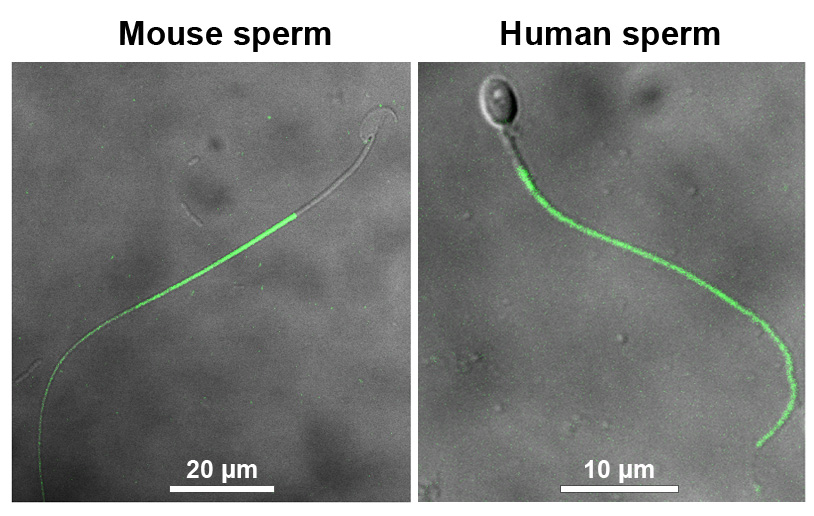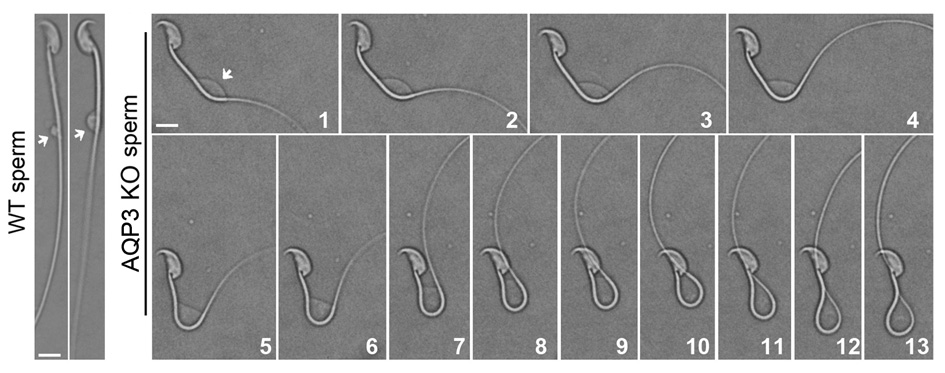In the journey from the male to female reproductive tract, mammalian sperm experience a natural osmotic decrease (e.g., in mouse, from ~415 mOsm in the cauda epididymis to ~310 mOsm in the uterine cavity). At one hand, the hypotonic stress upon ejaculation is beneficial for mouse sperm motility “start-up” (evolutionary trait from fish sperm); but like a double-edged sword, the hypotonic stress could also cause potential harms to sperm function by inducing un-wanted cell swelling. To counteract this negative impact, mammalian sperm have acquired mechanisms to drive rapid transmembrane water movement for efficient cell volume regulation. Previous physiological and pharmacological studies have shown that ion channel-controlled water influx/efflux is actively involved in the process of sperm volume regulation; however, no specific sperm proteins have been found responsible for this rapid osmoadaptation.
In collaboration with Prof. Tonghui Ma and Prof. Qi-xian Shi, the research team lead by Prof. Enkui Duan lab has revealed that aquaporin3 (AQP3) is a water channel localized in sperm tail membrane of mice and humans. Aqp3-deficient sperm show normal motility activation in response to hypotonicity but display increased vulnerability to hypotonic cell swelling, characterized by increased tail bending after entering uterus. The sperm defect is a result of impaired sperm volume regulation and progressive cell swelling in response to physiological hypotonic stress during male-female reproductive tract transition. Time-lapse imaging revealed that the cell volume expansion begins at cytoplasmic droplet, forcing the tail to angulate and form a hairpin-like structure due to mechanical membrane stretch. The tail deformation hampered sperm migration into oviduct, resulting in impaired fertilization and reduced male fertility.
These data revealed AQP3 as an essential membrane pathway for sperm regulatory volume decrease (RVD) upon physiological hypotonicity, balancing the “trade-off” between hypotonic induced sperm motility and cell swelling, thereby optimizing postcopulatory sperm behavior. Given the similar expression pattern of AQP3 in human sperm, the clinical implication of this study in infertile/subfertile patients warrants further investigation.
This research has been online published in Cell Reasearch:
Chen Q1, Peng H1, Lei L1 (1equal contribution), Zhang Y, Kuang H, Cao Y, Shi QX, Ma T, Duan E*. Aquaporin3 is a sperm water channel essential for post-copulatory sperm osmo-adaptation and migration. Cell Res. Cell Research advance online publication 7 December 2010; doi:10.1038/cr.2010
This research was supported by “the National Basic Research Program of China”and “the CAS knowledge Innovation Program”.

Figure.1 Immunofluorescence staining of AQP3 (green signal) reveals intensive localization at principal piece of mouse and human sperm tail.

Figure.2 Time-lapse imaging reveals sperm tail bending (Aqp3 null sperm) process forced by progressive membrane expansion upon physiological hypotonic stress. The cell swelling begins at cytoplasmic droplet (indicated by arrows). Note the wildtype sperm only shows mild swelling.


